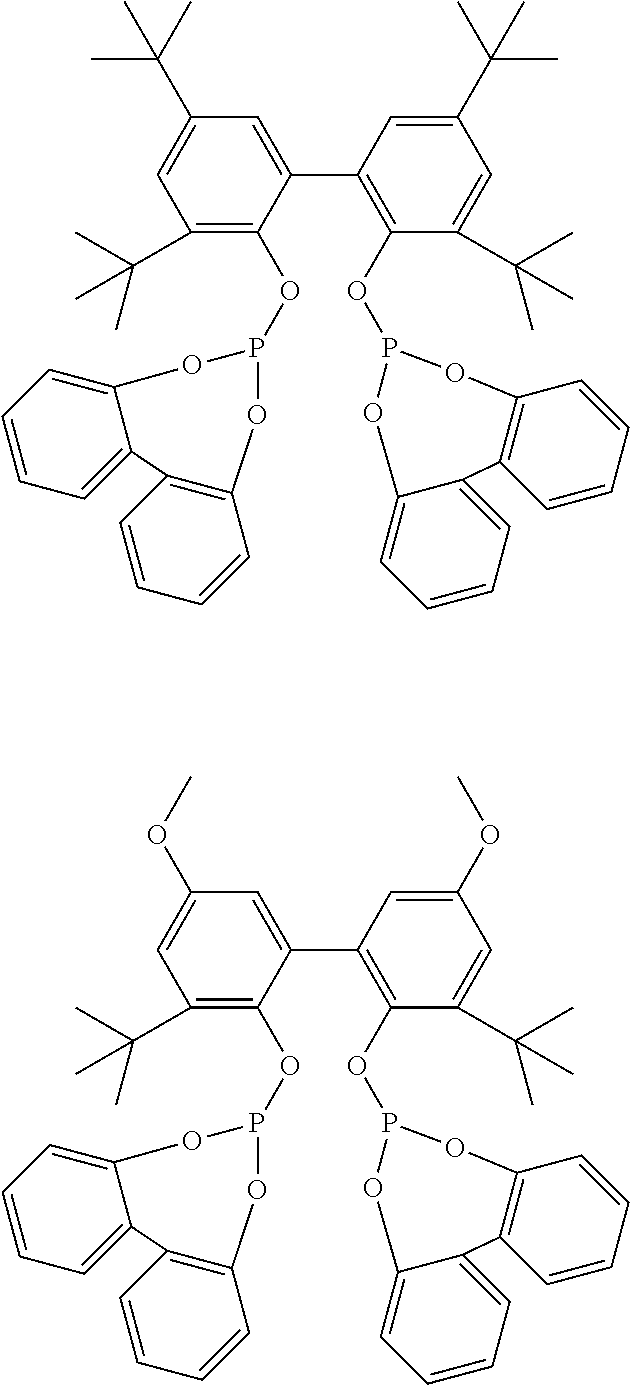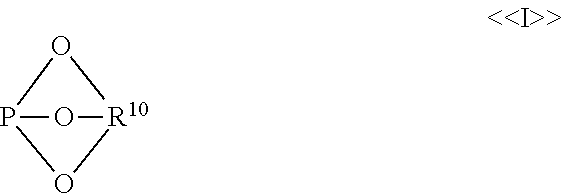Processes for producing organophosphorous compounds
a technology of organophosphorous and compound, which is applied in the field of organophosphorous composition, can solve the problems of requiring special attention, and affecting the stability of phosphite ligand, so as to reduce the phosphorous acid content of organophosphites and low levels
- Summary
- Abstract
- Description
- Claims
- Application Information
AI Technical Summary
Benefits of technology
Problems solved by technology
Method used
Image
Examples
examples
[0061]All parts and percentages in the following examples are by weight unless otherwise indicated. All manipulations are done in a N2-glove box or via Schlenk techniques to exclude air and moisture unless otherwise indicated. Solid Ligand A is used in the following examples:
[0062]Phosphorous acid content of solid Ligand A is determined by ion chromatography (IC) using a Dionex ICS 2100 ion chromatograph with eluent generation and suppressed conductivity detection including a carbonate removal device. The chromatograph is fitted with an IonPac AG11-HC Guard Column and an IonPac AS11-HC Analytical Column Data analysis is performed with Chromeleon 7.0 software. Unless otherwise indicated, samples are prepared by dissolution of the solid ligand (0.1 to 0.5 g) in toluene (5-10 mL) followed by extraction of the toluene solution with deionized water (8-15 mL). Phosphorous acid quantitation is reported as part per million by weight in the organophosphite. Samples containing very high level...
examples 1-4
[0063]Solid Ligand A (0.25 g) containing 1248 ppm phosphorous acid is weighed into 20 mL glass vials and dissolved in the specified organic solvent (6.5-12.0 g). The solution is treated with 0.5 g Amberlite IRA96 weakly basic resin (free base, wet resin) and the resulting suspension is magnetically stirred at ambient temperature for 2 hours. The supernatant is removed and extracted with deionized water (8.0 g); the aqueous layer is analyzed by IC. The results are summarized in Table 1.
TABLE 1Purification of Ligand A using Weakly Basic Resin.post-treatmentamine:phosphorousphosphoroussolventacid (molar)acid (ppm)Example 1toluene2711.6Example 23:128515.4butyraldehyde:texanolExample 3dichloromethane2837.7Example 4ethyl acetate31912.5
Comparative Experiments A-B
[0064]Solid Ligand A (0.25 g) containing 1248 ppm phosphorous acid is weighed into 20 mL glass vials and dissolved in the specified organic solvent (6.5-12.0 g). The solution is treated with 0.5 g Amberlite IRA96 weakly basic resin...
examples 5-6
[0065]Solid Ligand A (0.25 g) containing 1248 ppm phosphorous acid is weighed into 20 mL glass vials and dissolved in the specified organic solvent (6.5-12.0 g). The solution is treated with 0.5 g Amberlite IRA96 weakly basic resin (free base, wet resin) and the resulting suspension is magnetically stirred at 60° C. for 2 hours. The supernatant is removed and extracted with deionized water (8.0 g); the aqueous layer is analyzed by IC. The results are summarized in Table 3.
TABLE 3Purification of Ligand A using Weakly Basic Resin at 60° C.post-treatmentamine:phosphorousphosphoroussolventacid (molar)acid (ppm)Example 5toluene2957.9Example 63:13116.5butyraldehyde:texanol
Comparative Experiments C-E and Examples 7-8
[0066]Solid Ligand A (0.25 g) containing 10,200 ppm phosphorous acid is weighed into 20 mL glass vials and dissolved in the specified organic solvent (6.5-12.0 g). The solution is treated with 0.5 g Amberlite IRA96 weakly basic resin (free base, wet resin) and the resulting sus...
PUM
| Property | Measurement | Unit |
|---|---|---|
| temperature | aaaaa | aaaaa |
| temperature | aaaaa | aaaaa |
| temperature | aaaaa | aaaaa |
Abstract
Description
Claims
Application Information
 Login to View More
Login to View More - R&D
- Intellectual Property
- Life Sciences
- Materials
- Tech Scout
- Unparalleled Data Quality
- Higher Quality Content
- 60% Fewer Hallucinations
Browse by: Latest US Patents, China's latest patents, Technical Efficacy Thesaurus, Application Domain, Technology Topic, Popular Technical Reports.
© 2025 PatSnap. All rights reserved.Legal|Privacy policy|Modern Slavery Act Transparency Statement|Sitemap|About US| Contact US: help@patsnap.com



